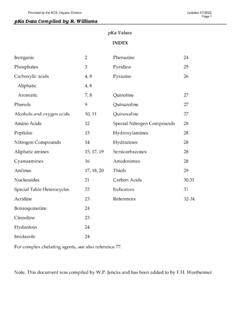Transcription of Naming and Indexing of Chemical Substances for Chemical ...
1 Naming and Indexing ofChemical Substances forChemical AbstractsTM2007 EditionA publication ofChemical Abstracts ServicePublished by the American Chemical SocietyNaming and Indexing ofChemical Substances forChemical AbstractsTMA publication of Chemical Abstracts ServicePublished by the American Chemical SocietyCopyright 2008 American Chemical SocietyAll Rights in the USAI nquiries concerning editorial content should be sent to:Editorial Office, Chemical Abstracts Service, 2540 Olentangy River Road, Box 3012, Columbus, Ohio 43210-0012 USASUBSCRIPTION INFORMATIONQ uestions about CAS products and services should be directed to:Countries not named above:Contact CAS Customer Care, 2540 Olentangy River Road, Box 3012, Columbus, Ohio 43210-0012 USA; Telephone 614-447-3700; Fax 614-447-3751.
2 E-mail For a list of toll-free numbers from outside North America, States and Canada:CAS Customer Care2540 Olentangy River Box 3012 Columbus, Ohio 43210-0012 USAP hone:800-753-4227 (North America)614-447-3700 (Japan Association for InternationalChemical Information)6-25-4 HonkomagomeBunkyo-ku, TokyoJapan, and Indexing of Chemical Substances for Chemical Abstracts 2007 102 Naming AND Indexing OFCHEMICAL SUBSTANCES101. the account which follows describes in consid-erable detail the selection of substance names forChemical Abstracts (CA)in-dexes, it is not a nomenclature manual.
3 It has the more restricted aim ofenabling a user ofCAindexes to proceed from the structure of an individualchemical compound to the place in the currentChemical Substance Indexwhere the particular index name and any associated index entries will be is the identical operation performed by aCAindexer when assigning anindex name to a new or previously unnamed substance. What follows, in fact,is a comprehensive summary ofCAsubstance Indexing policies, which covernot only conventional organic and inorganic compounds but other completelydefined Substances entered in theChemical Substance Indexand given CASR egistry Number identifiers.
4 These Substances include specific Chemical ele-ments, alloys, minerals, mixtures, polymers, enzymes, polysaccharides, and el-ementary Chemical nomenclature used by Chemical Abstracts Service (CAS) hasdeveloped in parallel and generally in accordance with the rules published bythe International Union of Pure and Applied Chemistry (IUPAC). Althoughthese rules provide unambiguous text equivalents for the great majority of sub-stances, equally acceptable alternative rules within the present IUPAC systemoften lead to two or more unambiguous names. This causes no difficulty in nor-mal scientific communication, but is totally unacceptable in a formal, rigidlycontrolled, alphabetic listing such as theChemical Substance Index.
5 Here thenames must be not only unambiguous, unique, and totally reproducible, but se-lected so as to bring the names of structurally related Substances into juxtapo-sition in the alphabetical listing. They must be equally derivable by index userssearching for information about individual Substances and by those who pre-pare the index. It is also desirable that both should be able to use mechanicalaids in name generation and major revision ofCAindex names was carried out in 1972 as the NinthCollective Index period began. Most trivial names were dropped; exceptionaltreatment for various classes of Substances was discontinued.
6 Where, becauseof the stereochemical complexity of a natural product name, a trivial name wasretained as a stereoparent (see 202), diagrams were furnished in theChem-ical Substance Indexto aid interpretation of index entries. The 1972 nomencla-ture revision and the reasons for its adoption are set forth in greater detail in theNinth CollectiveIndex Guideand in a journal article (J. Chem. ,14(1), 3-15).The preferredCAindex names for most Chemical Substances have beencontinued unchanged since that date. Changes in name-selection policies forthe Twelfth (1987-1991) and Thirteenth (1992-1996) Collective Index periodsaffect alloys, carbohydrates (lactams), coordination compounds, formazans,index name selection (multiplicative names), inorganic compounds (line for-mulas of clusters, intermetallic compounds), molecular addition compounds(common components.)
7 Hydrates), nitrilimines, onium compounds (free radi-cals), peptides, phosphonium ylides, phosphoryl halides and halogenoids,polymers (block, graft, and hydrolytic), ring systems (list of common systems),salts (lists of common anions), stereochemistry (sign of optical rotation), andzwitterions (inner salts, sydnones). The changes for the Fourteenth (1997-2001) Collective Index period affect coordination nomenclature, stereochemi-cal practices, and stereoparents. The most recent changes (2007) involve lo-cants, tautomers, and stereoparents. These changes, as well as the changesmade in 1972, and in the Tenth (1977-1981) and Eleventh (1982-1986) Collec-tive Index periods, are reviewed in Section G ( 225-293).
8 The nomenclatureof fullerenes is more fully documented in 163A of Section arrangement of sections is as Systems and General Principles ( 103-139) Skeletons ( 140-163A) Chemical Groups (Suffixes) ( 164-177) Classes ( 178-201) and Stereoparents ( 202-212) Substances ( 213-224) Substance Names for Retrospective Searches ( 225-293A) List of Substituent Prefixes ( 294) Bibliography of Nomenclature of Chemical Substances ( 295-308) Prefixes ( 309-311) Structural Diagrams fromCAIndex Names ( 312-318) arrangement within each of these sections is indicated by a key at the be-ginning of the the development of CAS policies for index names of Chemical substanc-es, no new nomenclature systems have been devised.
9 Adaptation of current IU-PAC rules to the specific needs of a highly ordered alphabetical index, notarbitrary coinage of new terms, has been the approach taken. It continues to berecognized by CAS that, while a unique name is needed for an index, and thatthis name, and the CAS Registry Number, are invaluable aids for substanceidentification, the use of this invariant index name for citation throughout everycontext in the scientific community is neither practicable nor desirable. But in-ternational agreement in Chemical nomenclature, as embodied in the rules ofIUPAC, IUB, and other organizations, continues to be of the greatest impor-tance in restricting thearbitraryproliferation of substance names.
10 Referencesto individual rules which have formed the basis of CAS policies recorded in thesections that follow have not been cited, but the selective bibliography of thenomenclature of Chemical Substances which constitutes Section J contains acomprehensive list of current accepted acknowledges the large contribution madeby Cecil C. Langham in helping to develop and recordCAname-selection pol-icies for the Eighth Collective period (1967-1971) during the years immediate-ly preceding his retirement in 1969. Dr. Langham s work constituted aninvaluable starting point for the revised name-selection policies introduced of namesName selection principlesOrder of precedence of compound classesSpellingPunctuationEnclosing marksMultiplicative prefixes Mono Functional derivativesOrder of citation of derivative termsLocantsfor substituent suffixesin substituent prefixes (radicals)





